DEW Haven/Yankee Jungle
Help enforce the Big Cat Public Safety Act, which is a federal law that prohibits contact between the public and big cats of all ages. If you see a social media post of someone posing with a cub that was taken after Dec. 20, 2022 when the bill became law in the U.S., then please capture a screen shot showing the date of the post and the contact to Cat@BigCatRescue.org There are only a few places that we think might still be offering cub petting on the sly and with enough evidence we can persuade law enforcement to take action. Participating in cub petting could result in 5 years in prison and a $20,000. fine.
Despite their name, DEW Haven is not a legitimate sanctuary. Although the heavily-edited Animal Planet reality show “Yankee Jungle” portrayed the Mount Vernon, Maine facility as a loving refuge for animals, DEW is a self-proclaimed exotic animal breeding farm and private zoo with a decades-long history of animal welfare violations, illegal wildlife trafficking, public safety issues, and deceptive behavior.
Over the past 15 years, DEW Haven has been cited for over 54 violations of the federal Animal Welfare Act. State investigators have described conditions there as “deplorable” and “untenable” and have seized several animals from the facility while recommending the revocation of its permits.

In 1998, Maine officials temporarily revoked DEW Haven’s exhibitor permit due to “failure to comply with state standards and regulations regarding the lawful and humane treatment of wildlife in captivity.” That year, federal authorities at the USDA fined them $4,500 for violations of the Animal Welfare Act.

An excerpt from a 1998 state investigator’s report. The investigation resulted in the temporary revocation of DEW’s exhibitor’s permit, and later that year, DEW was fined by the USDA for failing to comply with the Animal Welfare Act.
Although DEW Haven claims to be a sanctuary for rescued animals, most of their animals were born on-site or purchased from other private zoos. Unlike a true sanctuary, they routinely breed, buy, sell, and allow public contact with their animals, including newborn big cat cubs which are taken from their mothers immediately after birth for lucrative “encounters” with the public (an extremely inhumane practice which no legitimate facility would ever do).
At a 2016 public hearing on proposed revisions to Maine’s captive wildlife rules, DEW co-owner Julie Miner told those present that DEW is “a USDA licensed zoo” which has “bred and donated endangered species to other facilities for display.” At the hearing, Miner called proposed rules which would prevent private owners from breeding tigers “a big concern” because “they are one of the types of animals that attract visitors to facilities such as ours” and that banning private breeding “would affect our revenue and the ability to replace our own exhibit animals… …We also feel that listening to radical animal activists – who are pushing for no breeding, no zoos that aren’t accredited, etc. is a dangerous downward spiral – the fact is their only agenda is to have no animals in captivity.”
Former volunteers report that animals no longer wanted at DEW Haven are often “shot, sick, sold, traded, skinned and mounted, and some just disappear.” And although DEW claims to be run on a shoestring budget and begs for more donations to help their animals, the organization’s tax returns show significant annual profit going into the pockets of the owners, with very little of the public’s “donations” spent on animal care.
After reviewing 500 pages of government records, the investigative news outlet Mother Jones published a scathing indictment of DEW Haven, using it as an example of the “difficulties that state and federal wildlife officials have with effectively regulating the nation’s private zoos.”

“Unstable” Ownership

DEW is owned and operated by Bob Miner, a convicted felon with a 14 page long criminal record. Miner has been found guilty of seven felonies and four misdemeanors since 1981, including multiple counts of felony burglary, receiving stolen property, theft by unauthorized taking, illegal ownership of firearms, and misdemeanor assault.
Bob and his wife Julie are not accredited by any legitimate organization, have no formal education in caring for exotic animals, and have admitted to the press that they consider their facility a “farm” and their exotic animals as nothing more than “alternative livestock.” As recently as April 2016, the Miners proudly told the Portland Press Herald that they consider themselves “fly-by-the-seat-of-your-pants-type people” and refused to allow a reporter access to their property.
Bob Miner has a history of threatening and intimidating anyone who criticizes DEW. In 2002, he was arrested for harassment of a neighbor who criticized his operation, and in 2004, courts issued a temporary restraining order against him after he threatened former DEW volunteer Monica Hooper at a supermarket.

Hooper has stated that “these are not nice people running this facility. When you turn off the cameras and the public is off of the property, they drop the act.” She claims that she has been contacted by many other volunteers, neighbors, and DEW visitors who were disturbed by what they saw at the facility, but were afraid to speak up out of fear of retaliation. These whistleblowers write:
“I used to live next door to where he threw all the unused carcasses…acres of filthy rotting carcasses…not buried or burned …the smell was so bad we couldn’t even go outside…he is one crazy scary individual!…”
“We called every agency we knew of but no one would do anything about it. They said it was illegal but I heard no one dares to cross him because he is so unstable…ended up digging a big hole and putting the carcasses in it..then it rained and all the swollen carcasses were floating in it. Then it would overflow and the runoff flowed down the ditches on the side of the road into Echo Lake…the locals couldnt let that happen so they buried as many carcasses as they could with an excavator..then Bob sold the property to a relative no less…and they drilled a well right next to the mass grave…he never told them the difference! What a vile human being!…”
“You can certainly share whatever information I may have but I prefer to keep my name out of it as he is crazy and I have children and grandchildren in the area and I don’t trust him not to retaliate….”
“What I remember? Pigs and cows dying all up and down Ithiel Gordon Rd (adjacent to his property) with massive lacerations–blood everywhere. There is a little swampy area on I.G. road, just South of Walter Greene Rd where the bodies of numerous farm animals were found. A friend of mine also said he witnessed Miner’s step-son kill a dog with his bare hands when they were teenagers. There are some seriously messed up things happening there in my opinion. I’m normally the last person to play nanny–but really folks, if you are reading this, stay away from this place and this man.”
Animal Welfare Violations
DEW Haven has been fined multiple times by the USDA for chronic violations of the Animal Welfare Act.
In March 1998, DEW was fined $4,300 after inspectors witnessed injured animals, contaminated feed, and dangerous fencing. The USDA gave the Miners two options: they could pay the fine outright, or they could take that same money and use it to remedy the problems, with the condition that they show how the money was spent to improve the facility. DEW declined to improve their facility and chose to pay the fine directly.
In 2002, the USDA fined DEW $2,000 and cited the Miners for improper animal housing and unsanitary conditions, including a “drum of a liquid and bone mix” which left the USDA inspector “visibly upset.”
Recent USDA inspection records show that these violations continue. From 2004 to 2015 alone, DEW violated the Animal Welfare Act 54 times. Among the recent violations:
- In 2012, three bears were euthanized “on an emergency basis” after fighting with each other and sustaining severe injuries. The inspector wrote:
“According to the licensees, the older male [bear] had been showing behavioral changes (including aggression) for the past year, however the licensees did not communicate this observation to the attending veterinarian. Had they communicated the observation in a timely fashion, this traumatic incident may have been avoided.”
- Piles of garbage and feed waste with “waste odor” were found behind animal enclosures, and a fly infestation was reported near a cougar cub’s pen.

- Tigers, sheep, deer, and goats had little or no shelter from the elements, and another tiger was housed in a poorly-drained, damp pen, “a condition that could cause harm to the animal.”
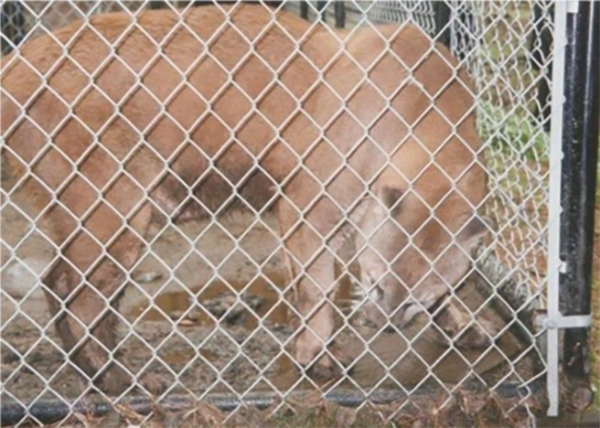
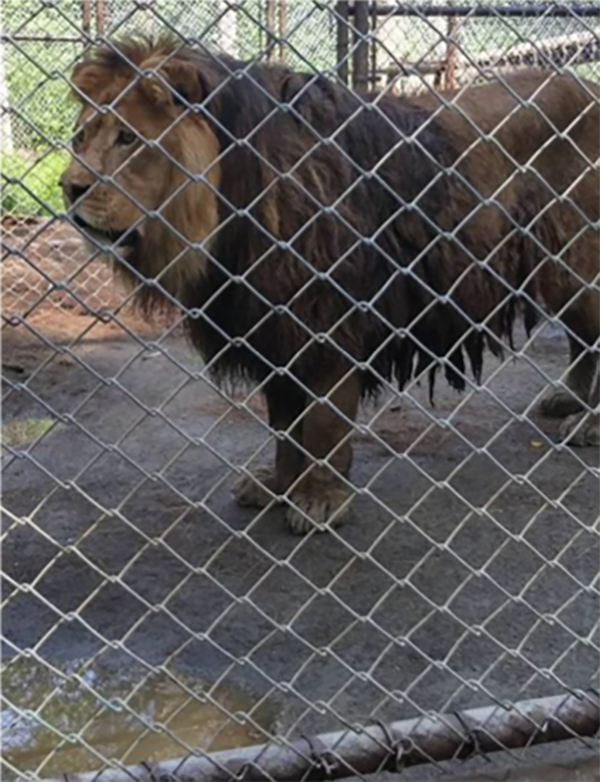
- Perimeter fences to keep the public away from adult lions and bears were inadequate or non-existent.
- Some animal feed was expired or contaminated with feces.
- Visitors were allowed to interact with an 8 month old, 130 lb. tiger which was far too large and dangerous to legally come in contact with the public.
- Shelters for tiger and lion cubs were inadequate and too small for the animals to have freedom of movement.

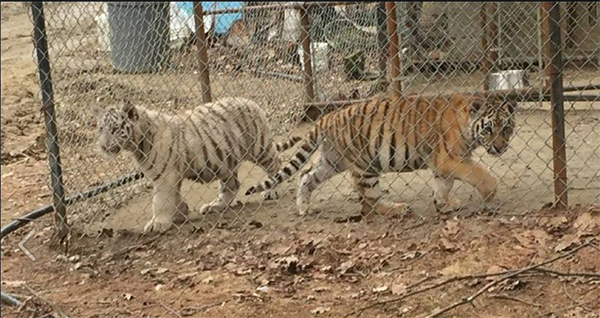
- A shelf in the black leopard enclosure was poorly-maintained and “could cause injury” to the animal, and a crowbar was left on the ground in the bobcat enclosure.
- There were “considerable unhygienic conditions” in the food preparation area.
- A gap in the lion enclosure was ordered to be closed to “minimize the risk of escape.”
- The public was allowed to interact with an adult tiger at distances “insufficient to assure safety,” and dangerous gaps were noted in the zebra enclosure.
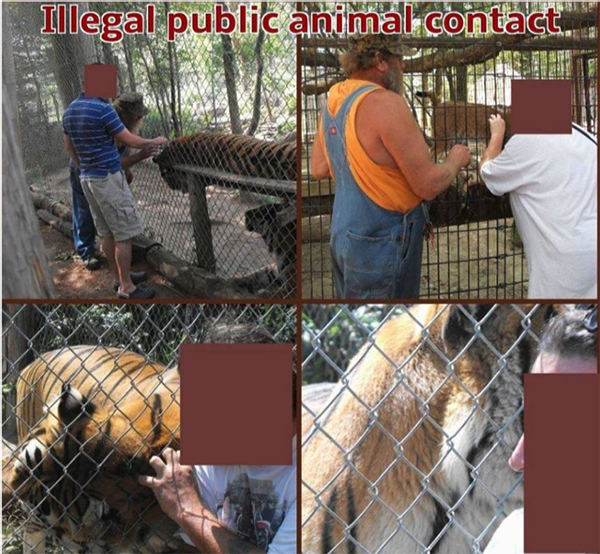
- Unused fencing, construction materials, and other trash was repeatedly found on the ground inside animal enclosures.
- Three adult tigers were being kept in enclosures insufficient to ensure their containment.
- A goat was observed with an “excessively long hoof” which could cause lameness.
- A livestock trailer used to transport animals had rusted out in some areas.
State Inspections
In 1998, DEW Haven was investigated under warrant by state inspectors after the Miners illegally imported several animals without the appropriate permits, then “knowingly and willingly” lied to officials about the animals’ origins. In a single 3-hour visit, the inspectors found a whopping 48 violations of state animal welfare laws, including:
- A black bear was being displayed in a cage with dirty water. Inspectors noted that “this bear was obtained from an animal dealer in New Hampshire and was imported into Maine without an importation permit having been issued. This bear also has been recently injured and has not been seen by a veterinarian or other trained personnel. It appeared that the bear may have broken its left front leg. The bear has no use of this limb and drags it on the ground.”
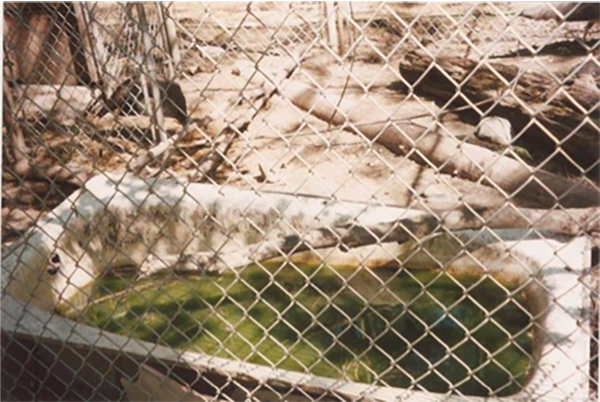
- A Bengal tiger was housed in a barren enclosure with no climbing or claw logs required by the state of Maine, and provided with “a bathtub containing 2 inches of dirty water for drinking purposes.” The roof of the enclosure “was not attached to the frame of the pen in such a manner so as to prevent escape.”
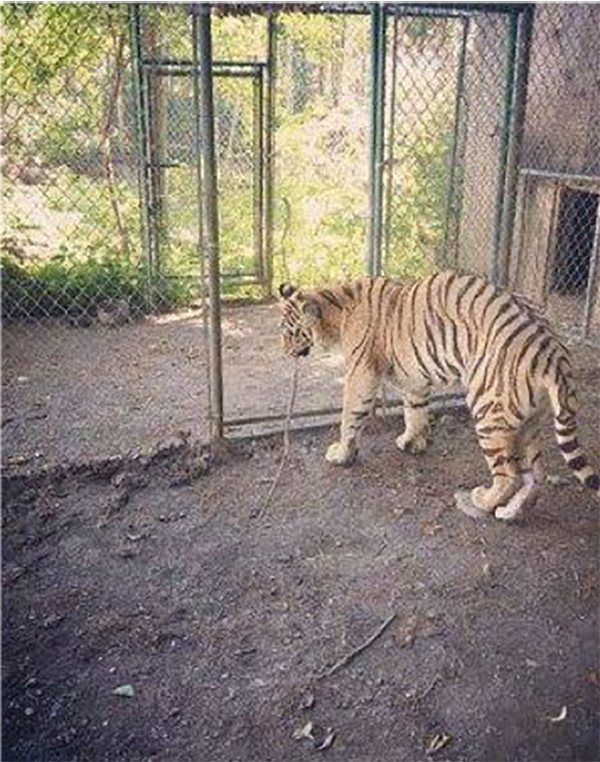
- A female lion cub was housed in an enclosure with no water. This enclosure lacked the legally-required roof to prevent escapes, and a fallen tree over the side of the enclosure provided “a mechanism for the lion cub to get out of the pen.”
- Two black leopards were kept in 12 by 12 foot cages that “had not been cleaned in some time.” Inspectors found an “excessive amount of feces” and maggot-infested meat in the cage. There was no water, and “both cages had barbed wire twists holding roof panels together and in such a manner so that the exposed ends of the barbed wire could cause injury to the cats.” An inadequate safety barrier was “close enough to the enclosure that a person could be in contact with one of the cats.”
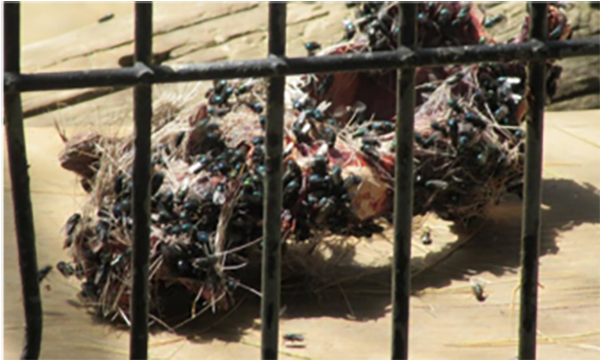
- Two adult lions were housed in an enclosure with no roof to prevent escapes and no provision for shade.
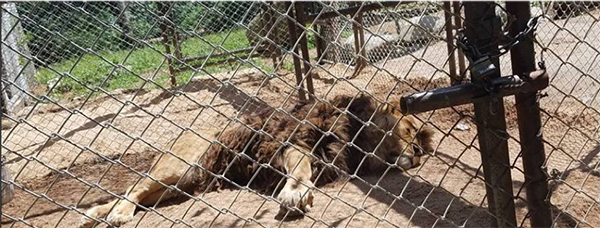
- A male mountain lion was housed in an enclosure with dirty water and feces that were “more than a day old”, while the enclosure for the female mountain lion had no shade and water that was “inadequate and in a dirty receptacle.”

- Primates were housed without water in cages that “do not meet minimum specifications.”
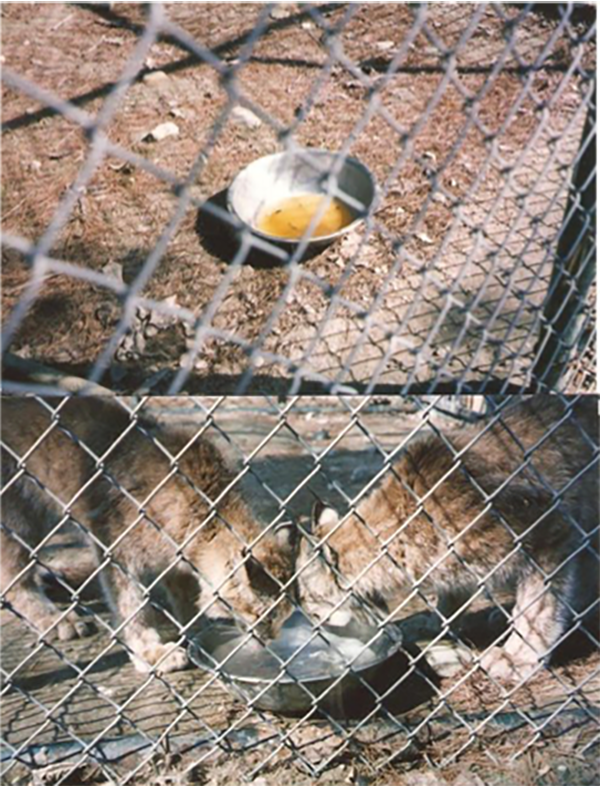
- An illegally-imported black bear cub was found in a cage, and a crested macaque had also been imported without the required permits.
- Many of the enclosures did not have adequate shelter for the animals to seek relief from the elements, and most animals had dirty water or no water at all.
- Drinking water and food dishes were dirty, and rats were seen at the facility.
- There was no written plan of action in the event of a disaster.
- Two bobcats were housed in enclosures with dirty water and no perch as required by state law.
As a result of this investigation, the state of Maine suspended DEW’s exhibitor permit for 90 days. The Miners cleaned up their facility and were allowed to resume operations, but quickly reverted to their old ways as soon as the permit was reinstated.
In May 2002, federal and state officials confiscated three illegally-imported cougars and a ringtailed lemur from DEW Haven. One of the cougars, Zach, had been left with bloody, abscessed paws after authorities suspect Bob Miner attempted to declaw the cat himself. The state’s report on a veterinarian’s assessment referred to the declaw as a “butcher job” which left Zach “crippled” and unable to walk.

A volunteer’s photo of a cougar’s abscessed paws before he was seized by the state.
One month after the 2002 confiscation, DEW was subject to an announced inspection by USDA veterinarian Clem Dussault, Maine Warden Investigator Phil Dugas, and state wildlife biologist Keel Kemper. Kemper later relayed his observations in an internal memo:
- Many of the animals being held do not have access to water. This is required by law, and no excuse no matter how dramatic can ameliorate this transgression. In each instance that water was not provided, a ready excuse was forthcoming, as to why this particular animal’s behavior (i.e. he knocks over his dish) prevented it from having access to water. I indicated to the Miners that this was unacceptable from the state’s point of view and steps must be taken to ensure that all animals have water available to them whenever they want it.
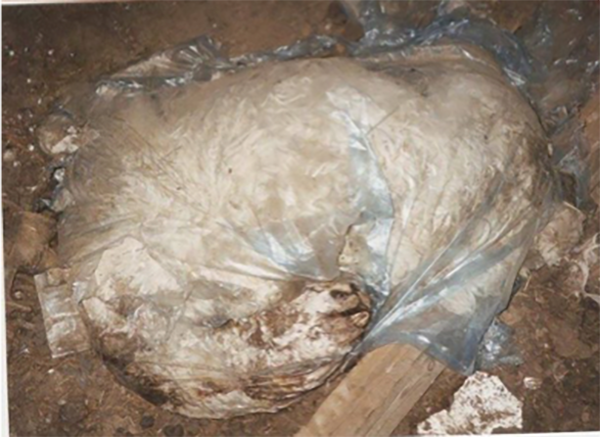
- Dead, decaying carcasses continue to be a problem. The current condition at DEW is unacceptable to any reasonable person. One cage contained two carcasses of what appeared to be geese. According to Julie Miner, these geese were killed by a Great Horned Owl this past winter. It appears that no one thought to remove these carcasses to an appropriate disposal facility. They were allowed to decay within the pen, in plain sight of the public. I observed bones, heads, hides, cast randomly about the property. A dead, bloated calf with approximately 1 billion flies was observed, just south of the Camel pen.
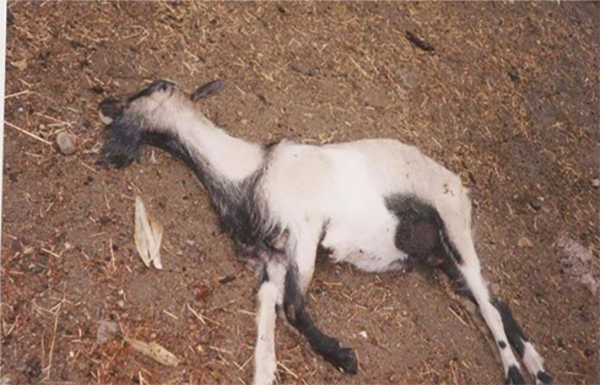
- In looking at the paper work associated with many of these animals, it appears that there is a tremendous amount of “donating” being made between animal propagators. These animals are changing hands yet, they are almost always “donated” from one propagator to the other. A normal circumstance would necessitate some payments and exchange of money. This is the only industry I know where everybody seems to donate to each other, “on paper.” I believe all of these “donations” are to cover the illegal trade of wildlife. This is sheer opinion on my part.
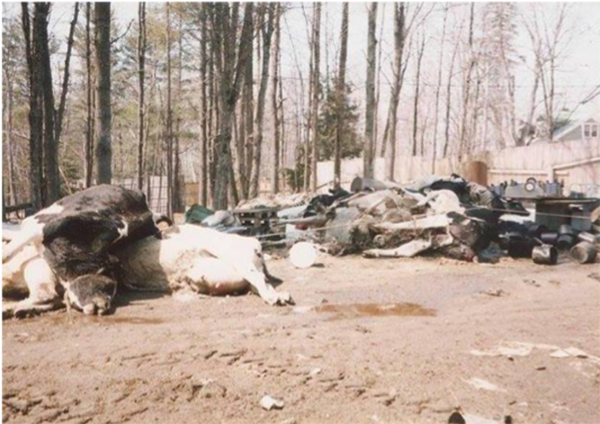
- Mr. Clem Dussault informed me that in 1998, DEW Animal Kingdom had to resolve a complaint of similar violations with [the USDA]. DEW was offered two options. They could pay an outright fine of approximately $4300.00 or in lieu of the fine, they could take that same money and put it into the facility to remedy the problems identified by the complaint. If the second option was chosen they would have to show how the money was spent to improve the facility. DEW chose to pay the fine outright as opposed to putting the money into their facility to solve the problems identified in the complaint.
I cannot recommend that DEW permits be reinstated at this time. I cannot recommend that DEW be allowed to have back those animals that were seized from them in May. (Federal Vet. Dussault concurs with this recommendation). It appears that DEW is not capable of compliance with the State of Maine Laws with regards to animals in captivity.”
The inspection summary filed by Mr. Dugas confirmed many of these observations:
“I am very surprised that DEW Animal Kingdom was not more prepared for this inspection,” he writes. “Watering of animals kept in captivity has been an issue at this facility in the past and continues to be an issue. It is unacceptable that several exhibits didn’t have water in the cages and no attempt was made at the time to correct the deficiency. The dead and decaying animals lying around the facility is unsanitary, unsightly, and unhealthy. This has also been a chronic condition at this facility. It is apparent to me that neither the watering nor the dead decaying condition is going to change. Based on the results of an announced inspection with notice I cannot recommend that the Department grant DEW Animal Kingdom a license to display wildlife.”
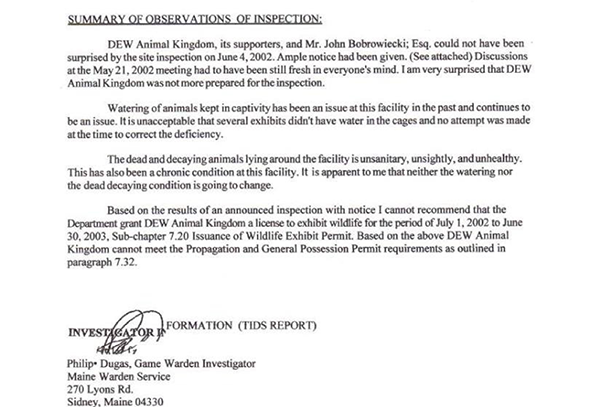
Shortly after this inspection, the Mount Vernon Code Office notified the Miners that their property was in violation of the town’s Junkyard Ordinance, while the local Health Officer, responding to a complaint, ordered that the dead carcasses be removed from the property as an “offense to public health” and noted that “this is not the first complaint about dead animals on this lot.”


After this inspection, the Kennebec State-Journal reported that Maine’s Department of Fisheries and Wildlife “was not going to renew [DEW’s] license” for 2002 because the facility “failed to comply with state standards and regulations regarding the lawful and humane treatment of wildlife in captivity.” However, after the Miners negotiated with state officials and made some improvements to their facility, the department suddenly changed its mind and decided to renew DEW’s permit against the recommendations of state and federal inspectors.
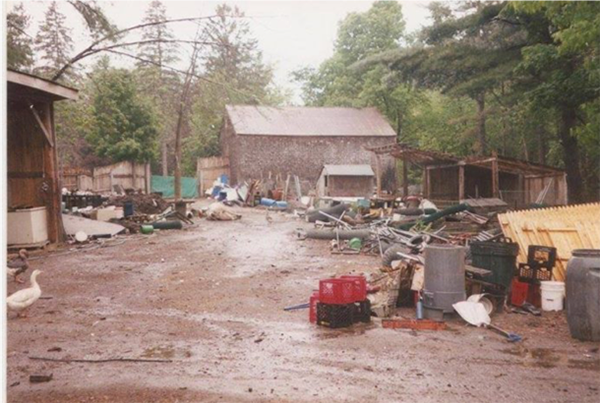

Cub Abuse
“Lion cubs are a dime a dozen.” – Julie Miner
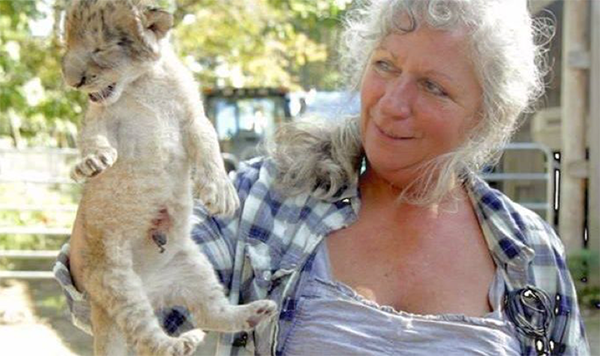
Julie Miner with a newborn lion cub. A former DEW volunteer alleges that Julie Miner has been seen taunting the cubs’ distraught mothers after taking them, saying “I got your baby!”
Unlike a true sanctuary, DEW Haven buys, breeds, and sells big cats, and takes cubs from their mothers at just hours old in order to handraise them and sell $50 “encounters” to the public. Many of the cubs used in these programs are far too young to be legally handled under USDA regulations. In 2014, state and federal officials ordered DEW to immediately stop selling tickets for the public to hold and bottlefeed newborn tiger cubs because cubs that small are not able to regulate their body temperatures and have an underdeveloped immune system, placing them at risk of disease and infection. According to Mother Jones, DEW complied, but “complained to the department that banning the shows meant lost revenue.”
The Miners have admitted to local newspapers that their cubs are fed goat’s milk, an entirely inappropriate diet for a growing big cat which can cause malnourishment. This report also notes that a lion cub’s mother remained visibly agitated after having her baby stolen from her.
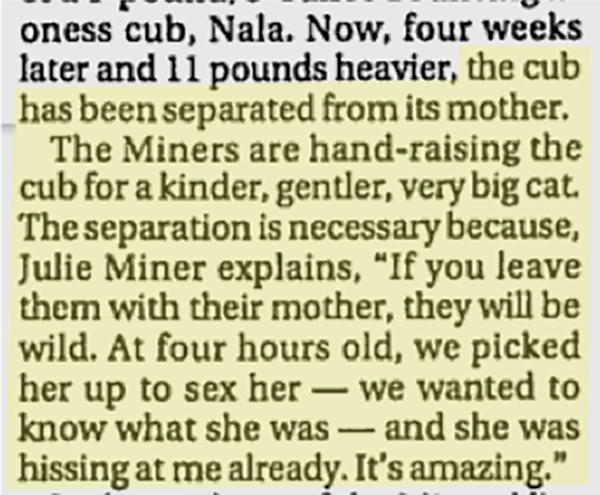

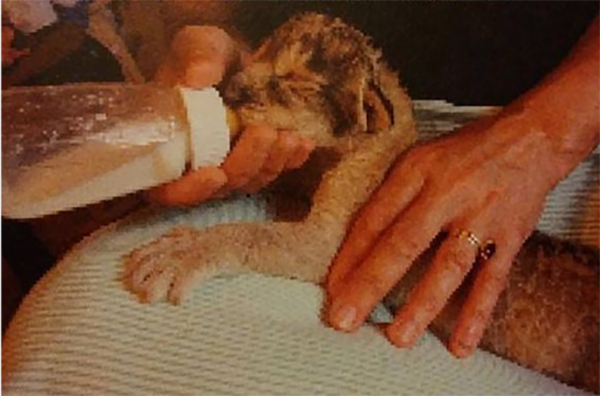
This tiny lion cub at DEW is very skinny and appears to be malnourished on a diet of goat’s milk.
If the cubs survive this abuse, they are kept by the Miners to breed more cubs or sold to anyone who will pay for them. DEW refuses to reveal the buyers of their cubs and has stated that once they have sold a cub, they are “not responsible for the lifetime of the animal.”
Bob Miner has bragged to tour groups about selling his cubs to circuses, and several of their cubs have ended up at Bear Path Acres, a notoriously abusive roadside zoo which had its license suspended in 2016 for severe and repeated violations of the Animal Welfare Act.
Born at DEW, this tiny black leopard cub was put on display at a local fair, after he was allegedly sold for $2,500 to Bear Path Acres.

A former DEW volunteer writes:
“Makeena was a white [tiger] cub brought in to DEW Haven in 2011 for breeding. She was stolen from her mother and used for shameless promotion from the get-go. She was put into a crate and carted around the property for viewing opportunities. Here is a picture of Makeena after she was pulled out of a crate and put out for photo ops. Please look at her hurt paw. Despite the injury there is no mention of a vet or even a thought for her own welfare, as Julie Miner shamelessly uses her for media attention in dozens of pictures.”
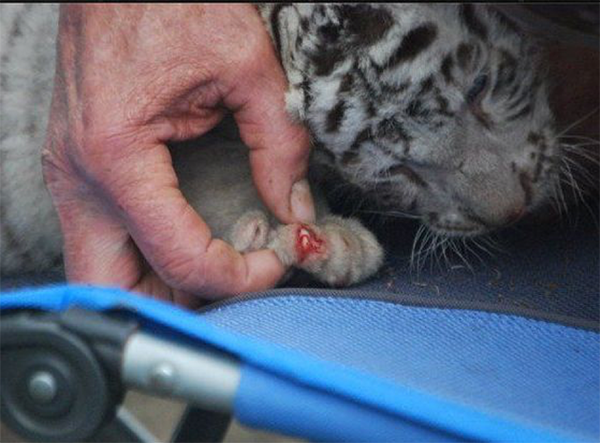
In 2014, Makeena gave birth to two litters of cubs, both of which were immediately taken from her to be handled and fed by paying customers. The Miners told the press and the public the common cub-petting lies: that the mother wasn’t caring for the cubs, that the cubs needed to “bond with people,” and that “they’ll go to nonprofit facilities focused on education and breeding programs because they are [an] endangered species.” Of the three cubs in one of Makeena’s litters, one white cub was euthanized due to birth defects caused by inbreeding, another white cub was “shipped out” to an undisclosed facility at just four weeks old, and the third, an orange cub named Aurora, “had trouble finding a buyer” and remained at the facility until the fall. A volunteer was told the cub went to a facility that had advertised online looking for a tiger and was given away online in response to a Craigslist ad.
On January 17, 2023 a whistleblower reported, “Aurora is Enma and she lives in Floyd Knobs, Indiana with a man named Steve Greeley.” The person claims to have photos and went on to say, “I have photos. I’m the one who knows she was sold to him my son loaded her onto the trailer.” We have asked for proof that money changed hands but they have not sent them yet.


One of Makeena’s 4 week old cubs, before being euthanized due to claims of a congenital neurological condition.
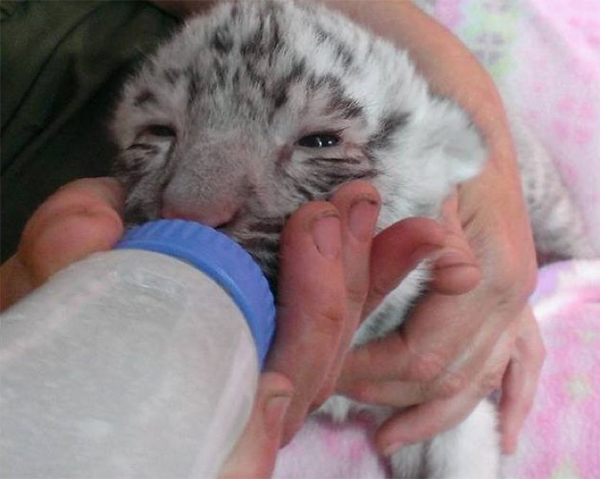
This cub is being fed illegally by a member of the public with dirty fingernails.
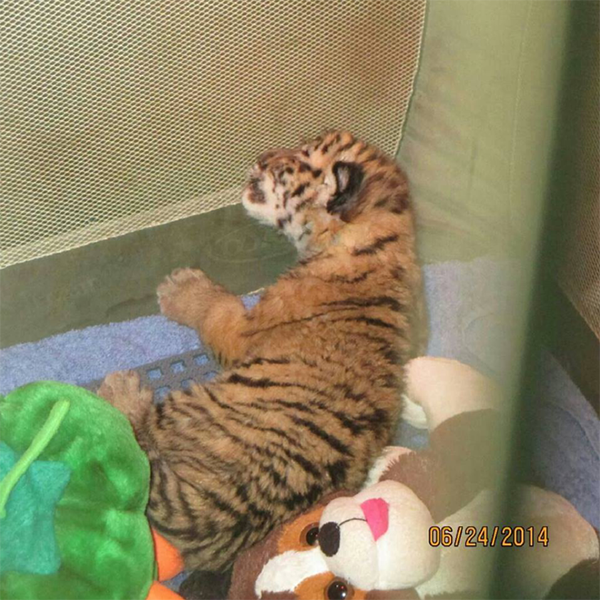
Aurora, as a tiny cub before being given away on Craigslist.
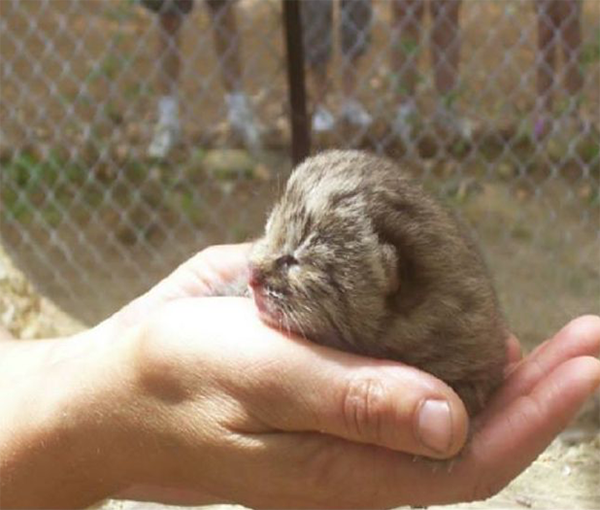
This newborn cub will never see his mother.
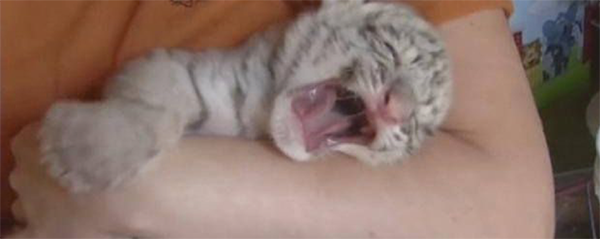
A cub being used for petting screams at DEW.

Newborn cubs are displayed in playpens at DEW. This exhausted cub wants to sleep.
DEW also purchases cubs from substandard private zoos and tells the public that they were “rescued.” This tiger cub was purchased by the Miners from Robert Engesser’s notoriously abusive Jungle Safari traveling exhibit and kept in the Miner’s living room in violation of Maine law.

Animal Escapes & Safety Issues

A protest sign by a former DEW volunteer details recent escapes.
Former DEW volunteers report that there have been multiple escapes of dangerous animals at the facility, including at least one during a public tour. None of these incidents were ever reported to local, state, or federal authorities as required by law. A whistleblower warns:
“The important thing to remember is that nothing has changed to prevent future escapes. There is no heightened preventive practices happening. If you are planning to take your loved ones there, there is a risk everyday.”
- In 2003, an adult male lion named Baghwa escaped from his enclosure at night and ate the domestic fowl roaming the property. He was witnessed by a family member who was driving into the facility at the time and saw Baghwa’s eyes in the headlights of her van. The Miners reportedly spent the whole night trying to get Baghwa back into his enclosure.
- Sometime within the last 10 years, a black leopard named Gabrielle allegedly escaped her enclosure during a public tour and was safely re-captured.
- In 2012, a wolf named Cherokee escaped his enclosure and was shot. Although DEW denies ever having a wolf named Cherokee, a former volunteer writes:
“One day [Cherokee] climbed up and over the fence of his enclosure and was loose on the path. Fortunately the public was not there. Cherokee encountered several geese in his path and killed one and threw it down. He moved on to the next, killed it and threw it down. He continued down the path repeating this over and over. Unable to contain him, the Miners shot and killed him. How do I know this? This is the story Julie told me herself when I went there and noticed he was missing. I haven’t heard him spoken of again. I believe in an episode of Yankee Jungle, Julie says they only had 2 wolves. No, Cherokee did exist and he was beautiful.”
- Around 2012, Bob Miner deliberately provoked a tiger in an unsafe enclosure with a large group of children present. The incident so disturbed one visitor that she filed a formal complaint with the state. It reads:
“The crowd was gathering around [Bob Miner]. There were probably 50 people total, mostly kids (maybe ages 7-10) from some organization, as they all had the same red t-shirt on. Miner threw a piece of meat over the fence into the tiger pen, and onto a 3 or 4 foot raised platform, that the tiger jumped up on to eat this meat. Miner was in-between the short barrier fence and the tiger’s enclosures chain link one.
This fence was about 12 to 14 feet tall but, with the subtraction of the platform’s 3-4 feet the tiger only had maybe 8-11 feet separating us from it. Miner then hit the fence near the tiger’s face, and the tiger would agro and start roaring and showing its teeth. Over and over Miner aggro’d the tiger while yelling to the crowd about the tiger’s behavior. All the children and adults were enthralled. The tiger was pissed. He was constantly showing his teeth, then roaring, slashing his tail against the fence, and crouching and flexing, over this piece of meat. I did the math on the fence level, where the tiger knows the meat flies over, and the tiger was at least 10 feet long, adding up to a disaster for all the people there. I told my friend and her kids that we were leaving. They were just like the crowd, enthralled and oblivious to the potential danger. I explained briefly that this was dangerous and as I pulled one of the children through the crowd with my friend and the other child following, Miner started yelling some rhetoric about the fences being electric and that the tigers could not get out. Not for nothing but, I had just seen this same man hitting the fence with his bare hand to agro the tiger. …This is a time bomb waiting to happen.”
- On June 25, 2016, a volunteer witnessed a cougar nearly escape in front of a tour group. The enclosure was not designed to contain an animal the size of a full-grown cougar and had a gap between the walls and the roof almost large enough to allow the cat to slip through.
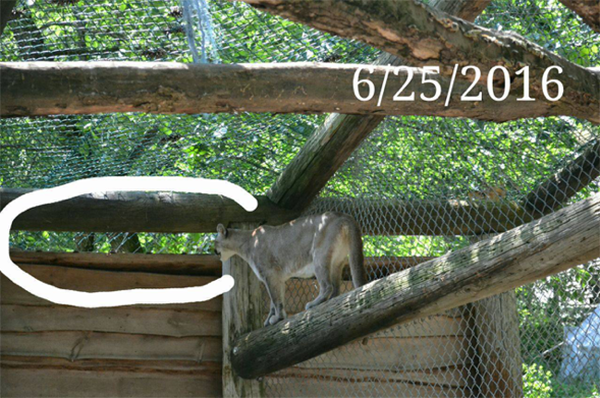
DEW has been cited numerous times for housing dangerous animals in enclosures deemed “insufficient to contain” them. These photos were taken as recently as 2015, and show a tiger cub being held in his cage by nothing more than a scrap of wood, an old dog leash being used to keep the public out of a lion enclosure, and fencing that is falling apart. The Miners refer to these enclosures as “rustic” and “recycled.”
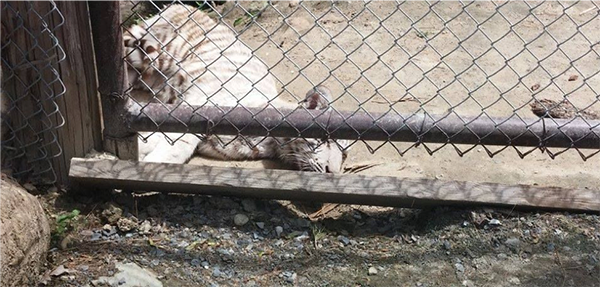
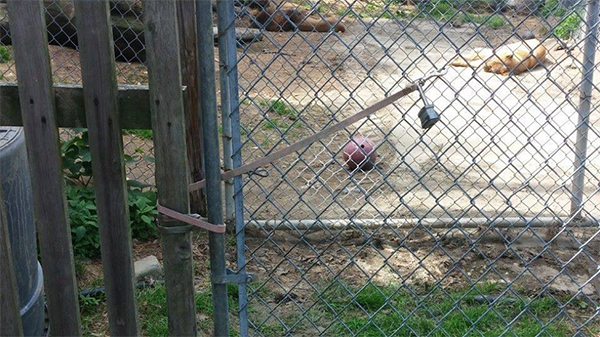

Bob Miner has continually disregarded laws which prohibit the public from having direct contact with large carnivores. He has been cited by the USDA twice for allowing the public to enter the barrier fence to pose with and touch adult tigers, and famously encouraged the public to feed candy to his black bear from their mouths. Facebook posts and other photos show that this dangerous behavior continues despite USDA citations.



In April 2016, the Miners would not allow a reporter onto their property under the excuse that because it was the offseason, “not all safety measures are in place.” Safety measures must legally be in place at all times, not just when the public is present.
In the late 1990s, Bob Miner often drove around with large big cat cubs in the back of his truck for the public to pet and admire, including this young tiger, photographed at a convenience store:

In 1997, a report sent to Maine’s Department of Inland Fisheries and Wildlife records an incident where Bob and Julie brought a leashed 8-month old leopard to the state agriculture department office for employees to pat and play with. The report states that the large cub was “too rough with his teeth and claws” and that he “lunged and grabbed” an employee walking down the hallway, who claims that the cat’s “head and paws were around my midsection.” The employee was startled but unhurt.
ANIMAL DEATHS
Multiple animals at DEW have died due to neglect, and some have been shot by the Miners in their cages. Animal deaths are rarely, if ever, reported to the public, and former volunteers report that when an animal dies, the Miners simply replace it with a new animal of the same name. The following information was provided to us by whistleblowers who witnessed these incidents while volunteering:
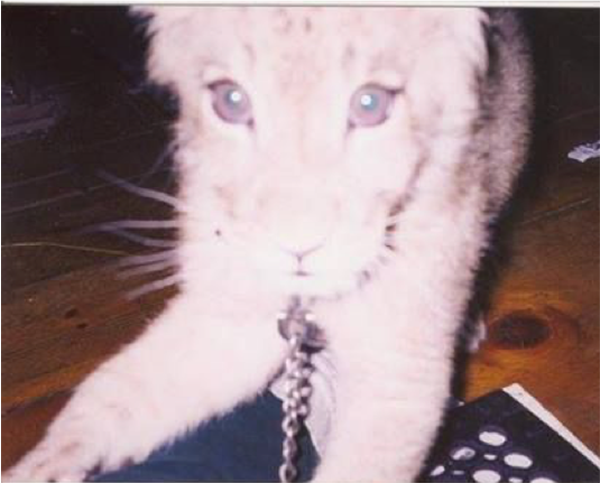
In 2000, a 4-month-old lion cub named Boonyea died of neglect. He spent most of his short life illegally chained to the floor in the Miner’s home with no water receptacle and only scraps of meat to eat. On March 31, volunteers noticed that the cub was not eating, drinking or defecating, and was lethargic and weak. Instead of seeking veterinary help for the cub, Bob and Julie Miner left him chained to the floor for three days while they displayed animals at the Augusta, Maine Sportsman Show. While they were away, Boonyea died. According to a volunteer:
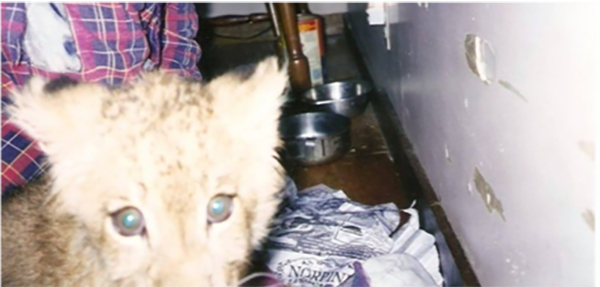
“[Boonyea] was in obvious distress during the weekend. I thought it was possibly an internal blockage since he was not ingesting fluids or food and not defecating. I witnessed this lion cub’s physical health deteriorate over the course of Friday March 31, 2000 to the evening of April 2, 2000, when the show was over and I went home. I returned the following day, Monday April 3, 2000 and Julie Miner told me that Boonyea had died during the night. Her facial expression and the tone of her voice was stone cold. I was told by Julie Miner that the lion cub had an internal digestive obstruction that he could not pass. If he had received proper veterinary care during his time of pain and distress on that Friday before, the blockage would have been removed and the lion would have lived. Julie Miner’s response:
“Lion cubs are a dime a dozen.”
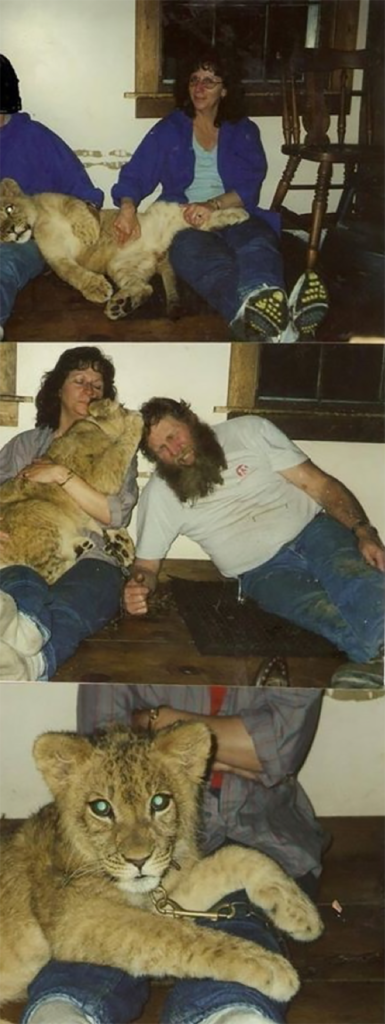
Boonyhea on a short chain in the Miner’s home. Although the Miners were aware that the cub was in distress, they left him to die in pain, with no medical treatment.
According to a volunteer who witnessed the incident: “In April 2000, I witnessed Bob Miner yell at and chase Seren,a female cougar, with a long pole to get her in a section of the enclosure so his devoted wife Julie Miner could shut her out. So Bob could show off for a tour crowd with Zach, a male cougar who authorities suspect Bob had attempted to de-claw himself and his efforts left Zach crippled and he limped instead of walking naturally for the rest of his life. Watching a wild cougar react as a wild cougar should against this type of handling was an image I shall never forget. I would also like to point out that not one of the spectators even so much as winced at this display. This illustrates how ignorant the general public are concerning the laws and proper care and handling of these animals.”
Because Seren did not produce offspring, and she was not crippled and could retaliate against Bob Miner’s regular abuse for spectators, she attacked Miner. Miner escaped with injuries to his shoulder, and soon after, Seren was shot to death in her cage in the late summer of 2001, at the will of Bob Miner himself. A convicted felon who is not legally allowed to posses firearms, who admits mental instability and illness to his patrons every tour he gives.
Seren was stuffed and sold by Miner. Her carcass is now in a local museum with a $1500 price tag.
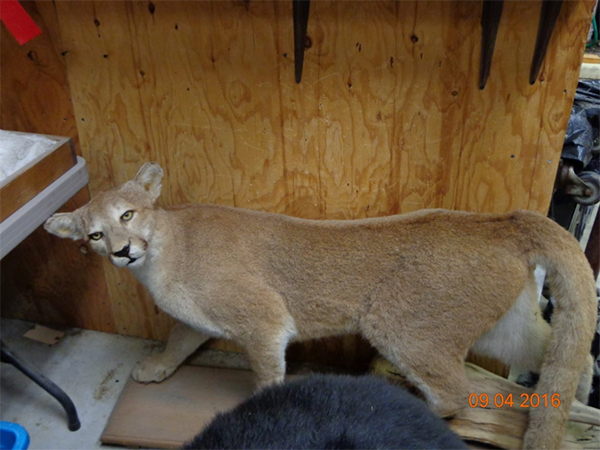
Seren, shot and sold by DEW.
In 2005, a male lion named Baghwa was shot in his cage by Julie Miner. There are conflicting accounts about what led up to the incident, but they all agree that Bob Miner was in the cage with Baghwa during feeding time and had forgotten to lock a gate separating him from the lion. When Baghwa felt that his food was threatened (possibly because Bob had been trying to steal his food in order to tease him), he retaliated and started to bite Miner’s face. Miner then bit Baghwa and managed to escape the enclosure with injuries. Julie Miner returned to the lion’s pen and shot him while Bob brought a backhoe to dispose of the carcass. Then, Julie drove Bob to the hospital.
When asked by a tour group why Bob didn’t call 911, he replied, “Because then it would have been public knowledge and they probably would have shut me down.” Baghwa’s body was given to a local trapper’s club and skinned.
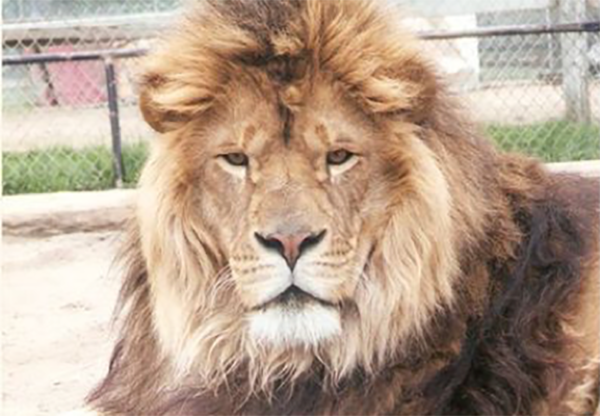
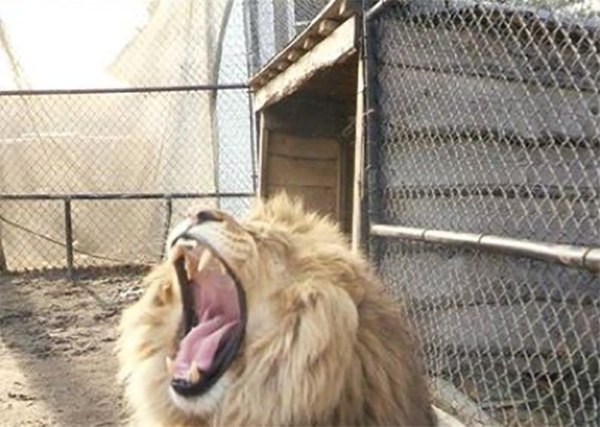
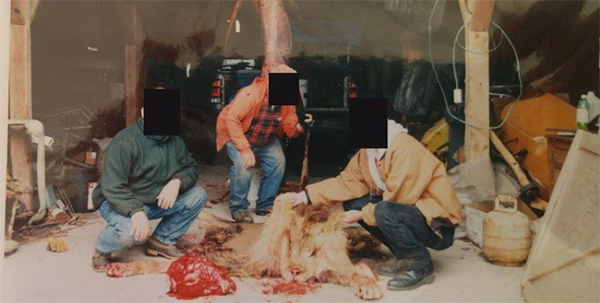
Baghwa, before and after his death.
Does DEW Need Donations?
Like most pseudo-sanctuaries, the Miners have DEW Haven registered as a nonprofit organization and tug on the public’s heartstrings by claiming that they operate on a shoestring budget and can’t afford to improve their ramshackle enclosures unless more people donate. This story doesn’t match up with DEW’s 2015 tax returns, which reveal that the zoo had over $200,000 in assets (including over $120,000 in cash) and raked in nearly $90,000 of profit during that year alone.
In 2015, $60,000 was spent on salaries for the Miners and their staff, while just $9,050 went to food and veterinary care for all 200+ animals living at DEW. By comparison, a legitimate facility will typically spend roughly $10,000 each year to care for a single adult tiger.
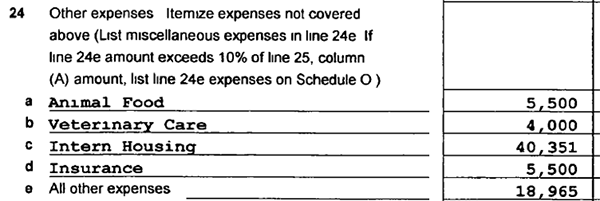
An expense report from DEW’s 2015 tax returns.
What happens to the rest of the public’s donations? Recent Facebook posts reveal DEW’s owners buying luxury cars and trucks while their animals live in conditions that they just “can’t afford” to improve:

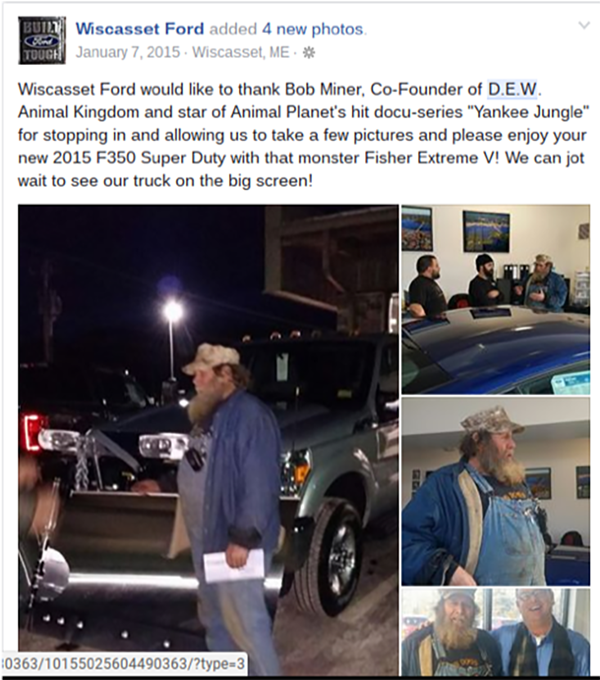
Tax returns also show that DEW only attributed 11.4% of its 2015 income to public donations. The rest of the income, totaling almost $280,000, was obtained through “unrelated business activities,” defined as commercial activity not substantially related to furthering the exempt purpose of the organization — in DEW’s case, animal protection and welfare.
Eyewitness Reports
For every animal welfare violation that inspectors can catch, there is often more abuse going on “behind the scenes.” Former volunteers and interns report seeing the following while working at DEW:
“I personally witnessed Bob attach a chain to a living cow in the back of his truck, attach the other end of the chain to a tree and drive away to get the cow out of his truck. The cow suffered with broken hips for days, but Bob would not put it out of its misery. A long as the cow was breathing the meat would stay fresh.”
“One time, they received a cow with broken back leg tendons, so it needed to be put down and couldn’t walk. It was going to be used for cat feed, which is normal for DEW and other zoos. They chained the cow to the back hoe and dragged it out to the pasture, by its back legs as it was in SEVERE pain. They left this female cow next to the pile of rotting animal carcasses in the sun, without shade or water, for over 3 days before they finally killed it. They told interns to “just not look at it” if we had to go into the cow pasture (everyone was visibly upset when they saw it). This cow suffered for many days, they didn’t want to ‘waste’ food and water on it since they were going to feed it out later that week.”
“The rabbits had been purchased in bulk to be killed off for serval food, as the servals prefer to eat smaller animals instead of large pieces of carcass. These rabbits were put in a large cage outside in the back where guests couldn’t see them. The cage was in the sun, in the middle of the summer. It looked like a multi-level ferret cage. These rabbits had no food or water for the first two days they were there, as they didn’t want to waste resources on feeding and watering animals that were meant to be food. The Miners eventually killed them to be put in the freezer with the rest of the rotting meat to be fed out at a later date.”
“A deer (that they did not know was pregnant) was found with the baby half way hanging out of the mother and it was dead. Then they decided the best thing to do was tranquilize it. It got many cuts and was bleeding due to trying to get away from Bob and the team. He got one dart in it and it didnt go down. He got a second dart in it and it didnt go down. Finally he tried to lasso it. He ended up getting the wrong deer and it was trying so hard to get away and it flopped onto a sharp tree trunk which looked like it hurt it and then it was making choking sounds because it was twisting its neck in the lasso. They finally got the pregnant mom and pulled the baby out which was dead. Total process took probably a little over 2 hours of stress for the poor deer that was already probably in pain from the failed birth. And a dead baby at the Miners farm due to lack of veterinary care. But also, Bob was becoming very angry and stressed during the process and at one point he told us all to get out of the enclosure and as I began to follow the man in front of me, he grabbed my arm hard enough to hurt and screamed at me to go the other way. I did not like that he grabbed me like that when I don’t even know the man. He not much as even said hi to me or any of the other interns I saw since my week of working there. I also had one experience when the cow got out when Julie Miner was telling us to close the DEW gate. As there were two gates open, one intern began to ask which of the two gates to clarify. Julie spat at her, “Dont you EVER talk when I’m talking” and drove off. They are just not the nice people that everyone thinks.”
“The entire property reeked of rotting carcasses and feces. Many enclosures were substandard, not large enough, filthy and muddy. A serval cat was being kept in a large dog kennel and I was told it was temporary but I went back months later and it was still there. They have too many animals to care for properly.”
Visitors to DEW Haven report seeing animals being deliberately teased by Bob Miner for the enjoyment of the audience:
“There was a large rock outside the hyena’s enclosure that was right next to the fence. Bob had a bucket of road kill meat sitting there, while he was sitting on the rock. He teased that hyena with a piece of meat until the animal was so frustrated that it lunged at his shoulder, mouth wide open, but hit the fence. We were totally appalled by Bob’s behavior. It was disgusting to see him tease that animal like that. From what I saw at my last visit, I do believe they should be closed. From the sound of it, things have gotten even worse for the animals living there than they were years ago.”
“As Bob came to the Binturong [a nocturnal animal] that was sleeping on a raised up platform… …Bob had what looked like a metal sheet pan, and slammed the sheet pan on the fencing where the Binturong was sleeping, yelling, “Get UP!!”, and something about how they sleep a lot, playing to the crowd. For the Binturong, when the sheet pan hit the fence, it made a huge metal on metal noise and he jumped up scrambling for a second and looked frightened back and forth. It then slumped back down, like this happens all the time. It looked broken and depressed to me, not tired and sleepy.
I’m so disturbed by what I saw. It has taken a long time for me to get the distance I need from this horrible situation. I feel bad and the sick feeling isn’t leaving me. I get how people are fascinated by these places. It was like all these people are hypnotized by the exotic animals and can’t see the abuse and danger. Maybe they don’t care. I’ve cried about what happened there that day. Some of the parrots had more secure and roomy pens than some of the larger animals… …It makes me sick.”
Update 3/9/2023 from a visitor: Good Morning, I read your article dated 1.23.2023 regarding Bob Miner and his treatment of animals.



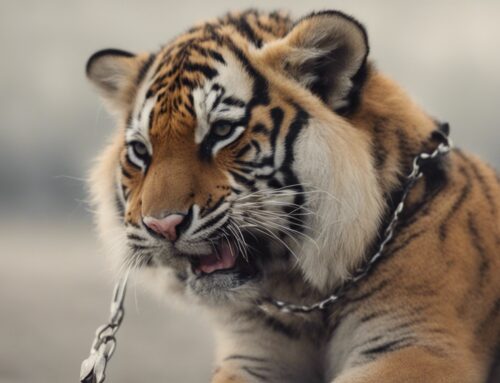

Leave A Comment
You must be logged in to post a comment.